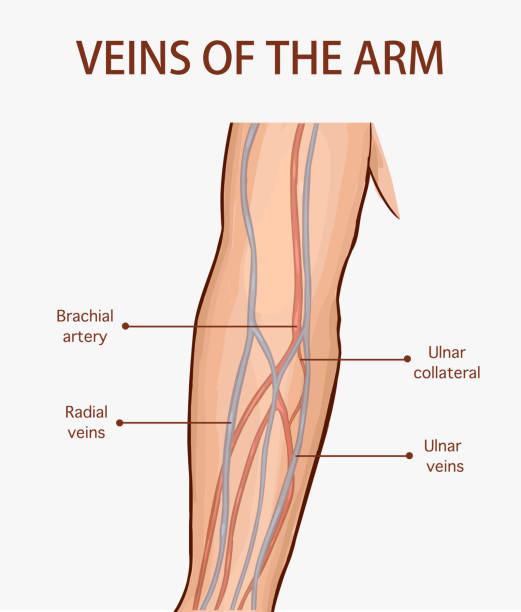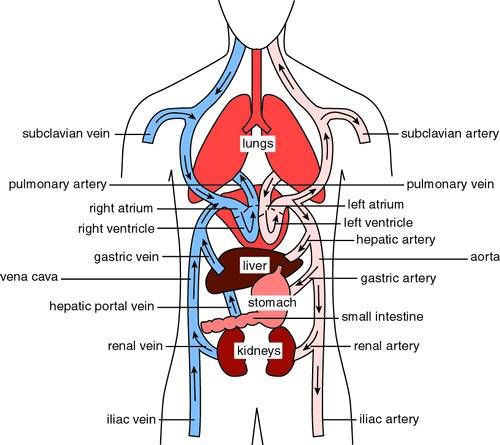The human circulatory system consists of a network of arteries, veins, and capillaries, with the heart pumping blood through it. Its main function is to supply the body’s various parts with vital nutrients, minerals, and hormones. The circulatory system works in tandem with the cardiovascular system to assist the body maintain a healthy body temperature, fight off disease, and attain homeostasis, or a state of stability between all of its systems.
Features of Circulatory System
- The components of the human circulatory system are blood, the heart, blood arteries, and lymph.
- Blood is circulated twice by the human circulatory system (double circulation), once for oxygenated blood and once for deoxygenated blood.
- Two ventricles and two arcuate chambers make up the four chambers of the human heart.
- Blood vessels can be found throughout the human body, which is home to the circulatory system. These are made up of capillaries, veins, and arteries.
- Transporting oxygenated blood and nutrients to every region of the body is the main purpose of blood vessels. It is also responsible for gathering metabolic wastes that must be eliminated from the body.
- The vast majority of circulatory system schematics do not graphically depict it.
The circulatory system is made up of four main parts:
- Heart
- Blood vessels
- Blood
- Lymphatic system
The Heart and how it Functions
The heart is a muscular organ positioned right between the lungs in the chest cavity. It is surrounded by the pericardium and is located in the thoracic region with a slight leftward tilt.
The four chambers of the human heart are divided into two upper chambers termed atria (plural: atrium) and two lower chambers known as ventricles. Its size is comparable to two adult hands clasped together. The heart keeps the circulatory system running continuously with its constant pumping.
The four chambers are fundamental to circulation. The ventricles force blood out of the heart while the atria take blood in from the veins. The myocardial layers of the ventricles are thicker than those of the atria because they must be significantly stronger to carry out this pumping activity.
Heart wall
The heart wall is composed of three layers. The outermost layer of the heart wall is called the epicardium, followed by the middle and most muscular layer, the myocardium, and the innermost layer, the endocardium.
Double Circulation
The way blood moves through the human body is peculiar and also highly effective. Double circulation refers to the process of the blood passing through the heart twice. Other creatures, like fish, have single circulation, in which the blood only makes one full circuit through the body.
The fundamental benefit of double circulation is that oxygenated blood is continuously delivered to all bodily tissues without being mixed with deoxygenated blood.
The Blood Vessels
The blood vessels are arteries and veins
The Function of the Arteries
Blood is transported from the heart through arteries. The tunica intima (inner), tunica media (middle), and tunica externa (outer) layers make up the arterial walls (outer). The thickest layer is often in the middle. It is composed of smooth muscle, which alters the artery’s size to control blood flow.
The three primary artery kinds are as follows. The farther they are from the heart, the smaller they become.
1. Elastic Arteries
The elastic arteries are the aorta and pulmonary arteries. In order to handle the surge and contraction caused by the blood pushing through with each heartbeat, they must be elastic since they get blood directly from the heart.
The aorta is the most significant artery in the body. Deoxygenated blood is delivered to the lungs through pulmonary arteries from the right ventricle. They are the only arteries that transport deoxygenated blood.
2. Muscular Arteries
Blood is transported across the body by the muscular arteries from the elastic arteries. They are constructed of smooth muscle that can swell and contract in response to blood flow. Examples of muscular arteries include the femoral and coronary arteries.
3. Arterioles
The arterioles, which carry blood from the muscle arteries to the capillaries, are the tiniest arteries. The capillaries link the veins that bring blood to the heart and the arteries that carry blood away from the heart.
The volume of material exchange affects how many capillaries are present in a biological system. Because their bodily systems require a lot of oxygen and nutrients, skeletal muscle, the liver, and the kidney all contain a lot of capillaries. One place that possesses no capillaries is the cornea of the eye.

The Veins
Veins allow the blood to return to the heart. The venules, the tiniest veins, are where the blood exits the capillaries. The veins enlarge more and more as the blood flows toward the heart.
The tunica intima, tunica media, and tunica externa are layers that make up the walls of veins, just as the arteries. The arteries and veins differ significantly in a number of significant ways.
Veins have less connective tissue and smooth muscle in their walls. Vein walls are more delicate than artery walls. Compared to arteries, veins can hold more blood and exert less pressure. Approximately 70% of the body’s total blood flow is found in the veins at any given moment.

Blood
Blood is the fluid connective tissue of the body and is an essential component of the circulatory system. Its major job is to transport nutrients, hormones, minerals, and other vital substances to various bodily areas. Blood travels via a specific network of passageways known as blood vessels. Human blood is made up of blood cells, blood plasma, proteins, and other mineral components like sodium, potassium, and calcium.
Components of Blood
Plasma
The fluid portion of the blood, called plasma, is made up 90% of water.
RBCs (red blood cells)/Erythrocytes
The primary function of red blood cells is to carry oxygen, nutrition, and other materials throughout the body. Additionally, these blood cells eliminate waste from the body.
Leukocytes, or White Blood Cells (WBC)
Specialized white blood cells serve as the body’s defense mechanism. By warding off infections and dangerous bacteria, they promote immunity.
Thrombocytes and Platelets
Cells called platelets aid in the formation of clots and stop bleeding. They take action at the location of a wound.
Lymphatic System
Lymph is a different bodily fluid that is part of the human circulatory system. It also goes by the name tissue fluid. The lymphatic system, a network of related organs, nodes, and ducts, is responsible for producing it.
In the tissues, digested food and absorbed fat are transported and circulated by lymph, a colorless fluid made up of salts, proteins, and water. Lymph, in contrast to the circulatory system, is not pumped; rather, it passively moves through a web of channels.
Functions of the Circulatory System
Transporting oxygen throughout the body is the circulatory system’s primary job. The following are some of the other significant duties of the human circulatory system:
- It aids in maintaining the systems of all the organs.
- It moves hormones, blood, nutrients, oxygen, and carbon dioxide around the body.
- It safeguards cells against infections.
- It serves as a conduit for communication between cells.
- The blood’s constituent components aid in tissue restoration.
